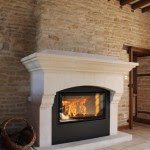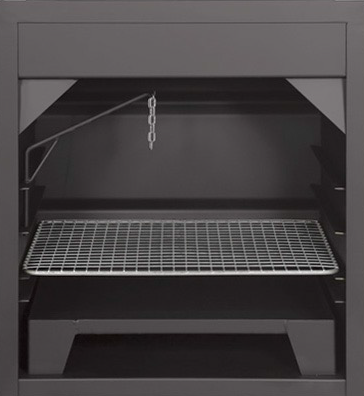By Lars Mytting, author of “Hel ved”
When the wood is not sufficiently dry, the heat in the stove is spent evaporating moisture and emissions of matter, and other pollution increases accordingly. The old superstition that the wood should be a little bit “damp” is nonsense. Ideally as little moisture as possible is best. For wood to be called “dry” it should have a moisture content of no more than 20%, but it is easy to get this down to 15%, without kiln drying and the improvement is significant.
Wood is carbon neutral and in countries like Norway, constitutes a large part of residential heating. Burning wood today is not about smoky and cracked old stoves, but modern combustion and air technology, high quality wood and sustainability. Modern stoves also provide a magical view of the fire (particularly in the case of the Bionic stove from RAIS). The heat that it is possible to get from a wood stove these days is unprecedented. It provides both deep radiation heating against the skin as well as quick heating of the room.
Many of the advantages however, are not apparent until the quality of the wood is just right. So in order to get efficient wood burning, you need to put a little bit of effort into the acquisition and storage of wood. Chopping wood yourself is possible in a lot of places, and gives you free or cheap heating. For some however this is not possible and so for those that buy wood there are some3 things to consider.
Buy Early
It is important to buy the wood early. When winter is approaching, it’s like the winter tyres on the first day of snow – it is common sense to be prepared. There is no reason to panic and go to the petrol station or garden centre to buy small bags of wood at ridiculous prices in the blistering cold. By contacting a wood dealer early in the season makes the situation clearer for everyone. Prices are often cheaper then, it is easier to get the wood delivered and the wood dealer can re-stock on their wood. Usually, most wood dealers can deliver dry wood as early as mid-summer. A great solution if you have the means to do it is to buy damp wood early in spring and dry it yourself. This will give you the cheapest price and you will get enough.
Buy bulk
Get as much as you can practically store. If the space is limited, ask if you can set up a subscription with your wood dealer. When you run out, you either have to get more or turn on the fan heater. Nowadays we are used to having everything readily available at anytime and anyplace, but this can unfortunately be devastating when the forces of nature sets in – because when everyone is cold, everyone wants wood.
It can happen that wood dealers in both urban and rural areas have run out during the harshest cold periods. It is easy to become a victim of people taking advantage to make a profit by turning up the price of wood at the same rate as the degrees are falling on the thermometer.
Estimate consumption
Keep in mind that burning wood is positive. If wood burning happens in the correct way, so that the pollution is minimal, wood is a CO2 neutral bio energy. The objective of many governments is to double the use of bio energy and in most cases, wood is the easiest and most practical alternative. So instead of turning on an extra fan heater when the electricity grid is already heavily loaded and the price of electricity is high, it is better to go out to the wood shed and think that perhaps it is too big, but at least it’s not empty. Wood is also a decorative feature and after a mild winter you can keep the surplus for next year.
Store in a dry place
There are many possible ways to store wood, from simple wood stacks to grand sculptures. We will only deal with the things that affect quality, and this involves storing the wood in an airy place and protected against moisture. It needs to be elevated from dirt ground and be protected from rain and snow by a roof. Wood absorbs rainwater quickly and if it remains in damp or wet surroundings, will get mouldy, this might also reduce its combustion properties. The same principle also applies to damp wood that you dry yourself, when it is even more important to place it freely so that it has proper flow of air from all sides. It isn’t rocket science to dry wood properly as long as it is chopped and stacked early in the spring. The low level of moisture in the air will make it dry surprisingly quickly – usually within three months. Sun and heat are two factors, but the element that really dries the wood is mainly the wind.
What doesn’t work
After drying the wood it is a good idea to put the wood in a place that is dry and easily accessible in the winter.
What absolutely never works as storage place is a temporary cover which is either:
- made half-hearted
- set up pending a better idea
- set up pending more time to spare or better weather
- tent look-alike constructions made from plastic or tarpaulin
- combinations of the four points above
If stored badly the problem is not only that the wood gets wet, but also that nature immediately starts its decomposition process. Birch is especially vulnerable to mould and fungi and regardless of wood type organisms large and small, like wood lice and worms, will with time make their dwelling in the wood and all the enjoyment will be gone.
What does work
This is easily avoided as If space allows it, a separate wood shed with great ventilation is the best thing. In many residences, the most realistic alternative is to store wood in a place that is less used during winter, for example a play house or veranda. Tarpaulins can make do as coverage for a while, but never wrap the wood so well that it can’t breathe, even if it is dry. It is however better to place the wood under a projecting roof or to make a simple slanting roof out from a wall. The roof can also be hinged so that it is easier to fill the storage space and it can also be removed during summer. The easiest way to store short wood (less than 30 cm) is in a bag, but one trick to stack loose, short wood against a wall, is to include a few longer pieces of plank at a 90 degree angle from the wall so that they stand straight out. When the wood is placed tightly against these, the stack will lock itself so that it doesn’t fall out or over.
If a free-standing, temporary wood shed is a possibility, you can make it quickly and easily from pallets and corrugated iron sheets. . The pallets are used as floor and walls and planks attached diagonally on the back lend the construction rigidity. Six large pallets make room for two cubic metres of wood (approx 70 cubic feet) and since they are the same colour as the wood, they don’t look too bad either. There are many variations that can be built according to need or aesthetic; most variants will do, as long as the roof is hard and tight and the construction solid enough to withstand wind and snow. A long projection helps to keep out driving rain and snow.
The view of a stack of wood is a view of something safe, and when you have the snug and cosy feeling of wood burning under your skin, you can look forward to winter. This is because you know you have things in order, that you are in sync with the seasons, and that you have enough wood and that it is good wood. A little bit of planning gives you a great feeling of control -which you can handle and live with the seasons. Then it’s no problem that the cold weather tries to make trouble outside, while the oldest source of heating known to man is crackling calmly in your fireplace.

 Scottish Stove Centre
Scottish Stove Centre
